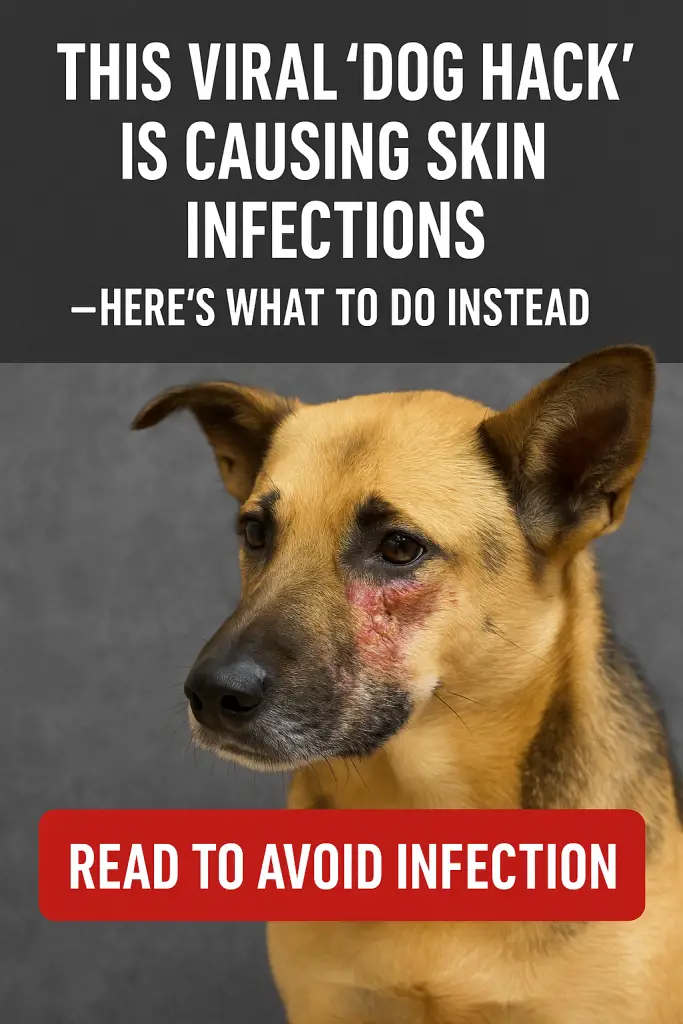
You’re looking at a dog with visible redness and irritation on its face—and sadly, this isn’t rare anymore. More and more dog owners are turning to “quick hacks” they find on social media. And while the intentions may be good, the outcome? Not so much.
That poor pup in the image? Likely the result of a trending “natural” hack that backfired. It’s a wake-up call for every dog parent.
🚫 The Problem With Viral Dog Hacks
The internet is packed with advice—but not all of it is safe. Viral “dog hacks” often suggest:
- DIY flea and tick sprays using essential oils
- Home-made grooming treatments using cling wrap or plastic
- Random kitchen ingredients applied to wounds or rashes
The big issue? Dog skin isn’t like human skin. It’s thinner, more sensitive, and reacts differently. What works on us can seriously hurt them.
⚠️ How These Hacks Cause Skin Infections
Let’s break it down real quick:
| Hack Type | What Goes Wrong |
|---|---|
| Essential oils (undiluted) | Causes burns, rashes, toxicity if licked |
| Vinegar/acidic solutions | Disrupts pH, stings, slows healing |
| Wrapping dog in plastic/foil | Traps moisture, creates bacterial breeding ground |
| Human shampoos or wipes | Strips natural oils, causes dryness and irritation |
| DIY pet perfumes | Often full of alcohol or fake scents—bad for the skin |
😟 Real-Life Consequences (What Vets Are Seeing)
- Redness, flaking, scabs (usually from essential oil or shampoo misuse)
- Hot spots caused by moisture and poor ventilation (like from wrapping tricks)
- Infections from broken skin being treated with the wrong stuff
- Burns when “natural solutions” like lemon juice or baking soda go wrong
And the worst part? Most of this could’ve been avoided with a little vet guidance.
✅ What You Should Do Instead
Rather than experimenting with online trends, here’s what actually works:
- Use vet-approved products only—no DIY unless your vet says it’s okay
- Always test new products on a small area first (wait 24 hours)
- Avoid wrapping your dog in anything unless it’s for a medical reason
- Stick to simple routines: gentle bath, dry completely, brush regularly
- Pay attention to ingredients—less is more when it comes to skincare
🐕 What To Do If Your Dog Shows Skin Problems
If your dog starts scratching or you notice red patches:
- Rinse thoroughly with cool water (remove any irritants)
- Avoid applying creams or powders without vet advice
- Watch for signs of infection: swelling, pus, strong odor
- Visit a vet if things worsen within 24 hours
🧴 Safe Alternatives You Can Try (With Vet Approval)
| Need | Safe Option |
|---|---|
| Moisturizing | Coconut oil (small amount) |
| Itch relief | Oatmeal bath (plain, unsweetened) |
| Wound care | Chlorhexidine solution (pet-safe) |
| Flea protection | Vet-prescribed topical or oral meds |
| Deodorizing | Dog-specific sprays (fragrance-free) |
🔚 Final Thoughts
We get it—pet parents want the best for their dogs. And sometimes that means trying new things. But when it comes to skincare and health, it’s better to skip the hacks and go with what’s proven and safe. Your dog can’t speak up when something hurts, so it’s on us to be careful.
Stick to trusted sources, ask your vet when unsure, and trust that simple care often works best. No trend is worth your dog’s comfort.
